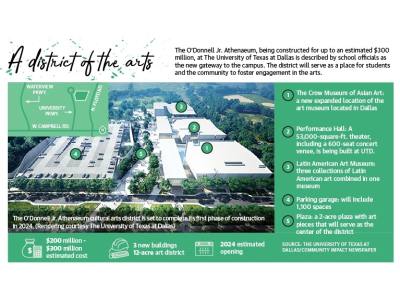Around 12 acres in size, the new district is called the Edith and Peter O’Donnell Jr. Athenaeum. It is expected to serve as the campus’ new cultural district, according to UT Dallas officials. The athenaeum will include a performing arts theater, two museums and a parking garage located in a central plaza in the southeastern area of campus.
The first phase of the project that is being built includes the Crow Museum of Asian Art and a parking structure, and it is expected to be complete by 2024. Enriching the arts is one of the key themes in the university’s strategic plan, UT Dallas President Richard Benson said during the May 11 groundbreaking for the athenaeum.
“We are widely known as a university that is strong in STEM and the management disciplines, but we are eager to be equally impactful in the arts,” Benson said.
A destination museum
The Crow Museum of Asian Art is located in Dallas and includes more than 1,000 works from Cambodia, China, India, Indonesia, Japan, Korea, Myanmar, Nepal, Pakistan, Thailand, Tibet and Vietnam plus a library of more than 12,000 books, catalogs and journals.
“This opportunity can be the catalyst for further expansion of the Crow Museum,” Museum Director Amy Hofland said. “We are working on a major acquisition that could double our size.”
Once open on the UT Dallas campus, the expanded Crow Museum is expected to become the fourth-largest Asian art museum in the country. The downtown Dallas museum will continue to operate, according to Hofland.
“This will be the first major art museum north of I-635 that was designed by a Pulitzer Prize-winning architect,” she said.
In addition to the Crow Collection, UT Dallas will display three collections of Latin American folk art as part of a planned 50,000-square-foot museum for the traditional arts of the Americas. This museum will include three donated collections: the Roger Horchow Collection; the Laura and Dan Boeckman Collection of Latin American Folk Art; and the Bryan J. Stevens Collection of Masks of the Sierra de Puebla.
“Bringing culture into a physical space on UT Dallas’ campus is a great opportunity for the students and the community,” Hofland said.
Nils Roemer, dean of the school of Arts, Humanities and Technology, said the athenaeum, which is a Greek term for a place dedicated to the goddess of wisdom, Athena, is designed to be used both as an educational tool for students and as a cultural “hangout” for Richardson.
The athenaeum is supported by a $32 million gift from the O’Donnell Foundation, which has contributed more than $900 million to UT Dallas since it was founded in 1957, according to campus officials.
Performing the arts
Another addition to the athenaeum is a 53,000-square-foot performance hall, according to university officials. The performance space, which would be the largest on campus, is expected to include a 600-seat concert hall, practice rooms, and choral and orchestra rehearsal rooms. The performance hall is expected to open by 2026.
Jonathan Palant, associate dean of the arts for the school of AHT, said the new hall will allow the school to expand its events, which operate out of a 200-seat concert hall and the 280-seat University Theater.
“Our performing groups are getting better,” Palant said. “This will allow us to scale with our growth and have a prominent place in the community, both on and off campus, to display the talent of our students.”
Palant said making arts easily available on campus is important to providing a cultural viewpoint for the community, especially with UT Dallas’ population being nearly 25% international students.
“Being a well-rounded student enables you to be a well-rounded citizen,” he said. “When we expose each other to arts from around the world, it makes us more accepting of others. Richardson being diverse itself will benefit from this global viewpoint.”
One of the biggest struggles UT Dallas has had in promoting arts education on campus is expressing to students the benefits of the program, Palant said.
“I think in lots of ways we were held back,” he said. “The campus has grown exponentially over the last couple of years, from 14,000 in 2006 to now over 30,000 students. There’s a lot of talk about how to [spread the idea of art] on campus.”
Roemer said he has discussed ways to make the arts more visible on campus, including displays throughout the arts buildings.
Expanding arts education
UT Dallas officials confirmed a major step toward committing to arts education this fall by combining the School of Arts and Humanities, and the School of Arts, Technology and Emerging Communication into a single larger school. The new school of AHT, which debuted this school year, is expected to expand previously offered curriculum centered on arts education.
“The idea behind this move is to have a strong, single academic presence for the arts at UT Dallas,” said Inga Musselman, provost and vice president for academic affairs, in a statement.
Roemer, who had served in a variety of roles with UT Dallas since joining the university in 2006, has been appointed the inaugural dean of the new school.
UT Dallas’ school of arts and humanities was first established in 1975. After the tech boom of the late 1990s, technology-focused classes started being added as part of the art department curriculum in 2002, before being split off into its own school in 2015.
The vision for the merged school has been discussed by UT Dallas officials since 2019, with Musselman conducting meetings on how to best merge these schools together.
“For example, we have a big, growing film studies program, but [the program] has been more about the study of film rather than the making of films,” Roemer said. “We also have a big animation games program, which means many of our classrooms are equipped with high-performing computers that can also handle film editing. We have the opportunity ... to educate in a new area of film production.”
According to Roemer, faculty will work together to determine the best ways to enhance academic programs.
“We have the opportunity within the coming semesters to add on classes that really benefit our students,” Roemer said.
Roemer said combining the schools will provide stronger support for students by adding staff members and programs. Last fall, the arts and technology schools combined had a total enrollment of approximately 2,100 students in their degree programs, including 103 master’s students and nearly 200 Ph.D. candidates, according to UT Dallas officials.
Under that enrollment, the school would become the fourth-largest school at UT Dallas. Roemer said the new department plans to hire between 8-10 new faculty members for the program.
“There are so many new combinations of classes that we can provide,” he said. “It will be fun to see how [the] faculty responds.”
Editor's note: This article has been updated to clarify the status of the Crow Museum of Asian Art in Dallas.







